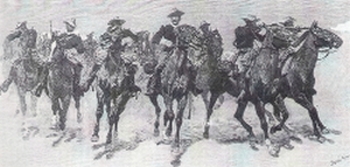After the Civil War, when the massive Union Army was disbanded, Congress could not ignore the contributions of about 200,000 black volunteers to the Union victory. Congress designated six post-Civil War regiments for black enlisted men in the reorganization act of July 28, 1866—the 9th and 10th Cavalry and the 38th, 39th, 40th, and 41st Infantry regiments (consolidated in 1869 into two infantry regiments, the 24th and 25th). The act marked the first inclusion of black men in the regular army. Soldiers of these regiments between the Civil War and World War I have come to be called “Buffalo Soldiers.” Their officers were white, except for five men, West Point graduates Henry Flipper (1877), John Alexander (1887) and Charles Young (1889), and two former enlisted men, Benjamin O. Davis and John E. Green, commissioned at the turn of the twentieth century. Davis became the first black general officer.
Buffalo Soldiers participated in central episodes of the American experience. They made essential contributions to western settlement, making maps, blazing trails, and improving roads; guarding settlements, roads, and stagecoach stations; and providing the reassuring military presence that helped encourage development. They fought in some major wars against Indians, against Spain in the summer of 1898, and in the harsh guerilla struggle against a native Filipino independence movement during 1899-1902. Twenty-three received the Medal of Honor.
It is generally supposed that the Comanche or Cheyenne first called them “buffalo soldiers,” and the best guesses are that the name reflected a perceived resemblance between the brown skins and nappy hair of some of the men and the color and texture of the fur of the bison. The earliest known user of the phrase was Frances Roe, the wife of an officer who served with the 10th Cavalry in Indian Territory during 1872-1873. Her letters were dated 1872 but not published until 1909.
William Leckie, in his path-breaking book, The Buffalo Soldiers: a Narrative of the Negro Cavalry in the West, claimed that because the buffalo was so important to these tribes the term was probably a sign of respect and that the soldiers so comprehended it. The assumption that the term was somehow honorific and that the Indians considered the black troopers exceptional has sometimes led to another, that the Buffalo Soldiers and the Indians viewed each other with empathy and respect. This cannot be proved, and the origins, significance, and prevalence of the phrase are not clear. Evidence that the soldiers themselves used or even referred to this title—in pension affidavits, newspaper articles, or other venues—has not turned up, so claims concerning their views of the usage remain unproved. The 10th Cavalry adopted the buffalo as a central element of its unit crest in 1911.

